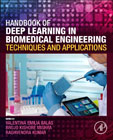
Handbook of Deep Learning in Biomedical Engineering
Balas, Valentina E.
Mishra, Brojo Kishore
Kumar, Raghvendra
Deep Learning (DL) is a method of machine learning, running over Artificial Neural Networks, that uses multiple layers to extract high-level features from large amounts of raw data. Deep Learning methods apply levels of learning to transform input data into more abstract and composite information. Handbook for Deep Learning in Biomedical Engineering: Techniques and Applications gives readers a complete overview of the essential concepts of Deep Learning and its applications in the field of Biomedical Engineering. Deep learning has been rapidly developed in recent years, in terms of both methodological constructs and practical applications. Deep Learning provides computational models of multiple processing layers to learn and represent data with higher levels of abstraction. It is able to implicitly capture intricate structures of large-scale data and is ideally suited to many of the hardware architectures that are currently available. The ever-expanding amount of data that can be gathered through biomedical and clinical information sensing devices necessitates the development of machine learning and AI techniques such as Deep Learning and Convolutional Neural Networks to process and evaluate the data. Some examples of biomedical and clinical sensing devices that use Deep Learning include: Computed Tomography (CT), Magnetic Resonance Imaging (MRI), Ultrasound, Single Photon Emission Computed Tomography (SPECT), Positron Emission Tomography (PET), Magnetic Particle Imaging, EE/MEG, Optical Microscopy and Tomography, Photoacoustic Tomography, Electron Tomography, and Atomic Force Microscopy. Handbook for Deep Learning in Biomedical Engineering: Techniques and Applications provides the most complete coverage of Deep Learning applications in biomedical engineering available, including detailed real-world applications in areas such as computational neuroscience, neuroimaging, data fusion, medical image processing, neurological disorder diagnosis for diseases such as Alzheimer's, ADHD, and ASD, tumor prediction, as well as translational multimodal imaging analysis. Presents a comprehensive handbook of the Biomedical Engineering applications of Deep Learning, including computational neuroscience, neuroimaging, Time Series Data such as MRI, fMRI, CT, EEG, MEG, and Data Fusion of biomedical imaging data from disparate sources, such as X-Ray/CTHelps readers understand key concepts in Deep Learning applications for Biomedical Engineering and healthcare, including manifold learning, classification, clustering, and regression in Neuroimaging data analysisProvides readers with key Deep Learning development techniques such as creation of algorithms and application of Deep Learning through Artificial Neural Networks and Convolutional Neural NetworksIncludes coverage of key application areas of Deep Learning such as early diagnosis of specific diseases such as Alzheimer's, ADHD, and ASD, as well as tumor prediction through MRI and translational multimodality imaging and biomedical applications such as detection, diagnostic analysis, quantitative measurements, and image guidance of ultrasonography INDICE: 1. Application of deep learning in biomedical engineering 2. Applications, algorithms, tools directly related to deep learning3. Computational Neuroscience; Neuroimaging and Time Series data (including MRI/fMRI/CT, EEG/MEG, etc.) studies;4. Data Fusion for HealthCare, especially Biomedical images of different nature (X-ray, CT, etc.); 5. Deep neural network in medical image processing (RTG, USG, CT, PET, OCT and others)6. Early diagnosis of specific diseases like Alzheimer, ADHD, ASD etc7. Manifold learning, classification, clustering and regression in Neuroimaging data analysis;8. Multimodal imaging techniques: data acquisition, reconstruction; 2D, 3D, 4D imaging, etc.)9. Optimization by deep neural networks, Multi-dimensional deep learning10. Prediction of tumor from MRI using deep learning11. Theoretical understanding of deep learning in biomedical engineering12. Translational multimodality imaging and biomedical applications (e.g., detection, diagnostic analysis, quantitative measurements, image guidance of ultrasonography)
- ISBN: 978-0-12-823014-5
- Editorial: Academic Press
- Encuadernacion: Rústica
- Páginas: 332
- Fecha Publicación: 01/11/2020
- Nº Volúmenes: 1
- Idioma: Inglés
